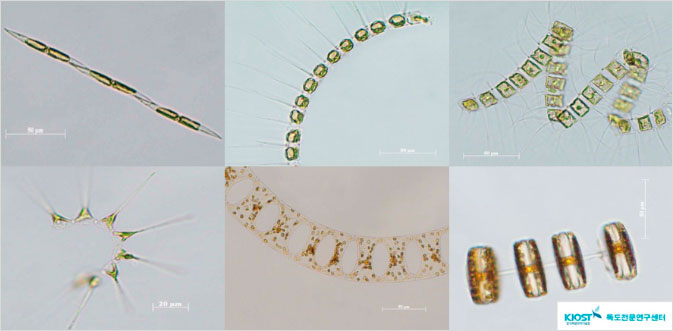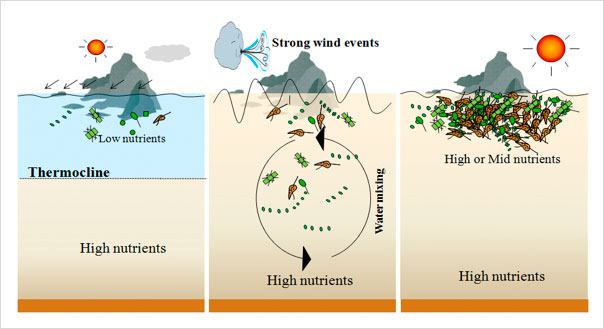Dokdo Island Effect
What is the Dokdo Island Effect?
A complex water mass [1] is formed in the waters around Dokdo due to the mixing of warm and cold currents. The mixing of water masses frequently occurs in such water masses due to friction with the topography of the island that results from the shallow depth. Moreover, strong winds that frequently occur on the east coast, on one hand, cause strong vertical mixing of the waters around Dokdo, but on the other hand, also play an important role in supplying the abundant nutrients [2] from the bottom layer to the surface layer. The nutrients supplied temporarily in this way have a significant influence on the growth of phytoplankton in the oligotrophic sea areas around Dokdo [3]. In particular, the upwelling phenomenon [4] occurs intermittently in the winter and spring, and this phenomenon is referred to as the “island effect.”
The research team of the Korea Institute of Marine Science and Technology confirmed through a detailed survey of the waters around Dokdo that vertical mixing of seawater clearly appears from a depth of 200m to 80m. In fact, vertical mixing due to Dokdo’s island effect supplies high concentrations of dissolved nutrients in the bottom layer to the upper layers, and the nutrients supplied at this time are plants that photosynthesize in the upper part of the photic zone [5] and act as a detonator for the growth of plankton.
In addition, the flourishing of phytoplankton due to the island effect is expected to play an important role in the function of zooplankton, which feeds on phytoplankton, the anadromous fish unique to the East Sea, and serve as a nursing ground [8] the young [7] and juvenile [6] sedentary fish of Dokdo.
The Relationship between Nutrients in the East Sea and Phytoplankton
It is a widely known fact that phytoplankton mainly occurs in the spring and autumn in the temperate seas. In the spring, nutrients supplied by the mixing of water layers in the winter increase insolation and proliferate phytoplankton centered on diatoms (Figure 1).
 [ Figure 1. Diatom Phytoplankton]
[ Figure 1. Diatom Phytoplankton]
However, in the summer, when nutrients in the upper part of the photic zone are depleted due to stratification [9], dinoflagellates take advantage of their day-night vertical movement and photosynthesize near the surface. Then, at night, they move to the lower layers and ingest nutrients to proliferate (Figure 2). Then, in the autumn, when the stratification is relieved due to the temperature drop on the surface layer, nutrients are once again supplied from the lower layers, resulting in the proliferation of phytoplankton centered on diatoms.
 [ Figure 2. Dinoflagellates ]
[ Figure 2. Dinoflagellates ]
The distribution of nutrients in the photic zone is an important factor in controlling the growth and disappearance of phytoplankton. It is either eluted from the sediment by a biochemical reaction or carried o the top of the photic zone through physical mixing with the lower layer. In addition, some of the nutrients have weak storage stability in the wind that is re-eluted into the sweater through a reduction process, but their circulation path and behavior are very complex. Therefore, a clear understanding of how nutrient flow changes is very important for assessing the characteristics of phytoplankton growth.
Seasonally, the productivity of phytoplankton remains low from January to March and it is the spring bloom period between March and May [10]. On the other hand, a low bio- mass of phytoplankton is maintained between June and August due to the depletion of nutrients in the photic zone, and the productivity of phytoplankton gradually increases in the southwest part of the East Sea from September and expands uniformly to the central sea area from November to December.
The waters around Dokdo showed relatively high nutrient concentrations compared to the open sea, even in areas far from the coast due to the island effect, although they were generally similar to the overall productivity fluctuation trends of the East Sea. In addition to the influence of the island effect, the phytoplankton species and proliferative characteristics are likely to differ depending on the route through which the phytoplankton generated in the eastern coast flow into the Dokdo area.
Observation of the Island Effect Around Dokdo
To thoroughly understand upwelling of the coast and the island effect due to strong winds, the research team focused on before and after the passage of strong low pressure system in the spring, and identified the cluster structure of phytoplankton along with satellite data, the marine environment, and the physical vertical structure. On May 3, 2017, strong low pressure system passed through the waters around Dokdo, and the southern winds prevailed. On May 12, about 10 days later, a high amount of phytoplankton was observed in the waters around the route the East Korean Warm Current passed.
The horizontal population composition of phytoplankton was dominated by diatoms at an extremely high density between the Uljin coast and Ulleungdo, which were strongly influenced by the East Korean Warm Current. Meanwhile, the islands around Ulleungdo and Dokdo, which are relatively open seas, Heterosigma akashiwo, a type of microscopic algae, maintained a high population due to the island effect. The vertical distribution of total chlorophyll, which can measure the presence of phytoplankton, was observed in the subsurface Chl-a maximum layer (20m) between Uljin and Ulleungdo [11], and was observed to be uniformly high across all layers from 30 to 40m around Ulleungdo and Dokdo.
Ultimately this suggests that a large amount of phytoplankton was produced by nutrients supplied to the upper part of the photic zone due to the strong mixing of water layers due to the island effect after the passing of the low pressure system (Figure 3).
 [ Figure 3. Schematic diagram of the Dokdo Island Effect ]
[ Figure 3. Schematic diagram of the Dokdo Island Effect ]
References
- [1] Water mass ? a seawater mass that can be distinguished separately from the surrounding seawater due to its almost uniform water temperature and salinity.
- [2] Nutritive salts - ? a general term for salts such as silicon, phosphorous, and nitrogen in seawater.
- [3] Oligotrophy - refers to the state when there are few nutrients dissolved in the water and productivity is low.
- [4] Upwelling - a phenomenon in which relatively cold seawater in the ocean pushes through surface water from below.
- [5] Euphotic zone, photic zone ? a depth at which light is transmitted up to 1% and water layer receives sufficient light for photosynthesis. In the case of the ocean, the thickness of the water layer varies depending on the amount of light up to 200m.
- [6] Juvenile ? the developmental stage after the late larvae, and while it has the characteristics of the species, the color or spots still differs from that of an adult fish, and refers to a fish of a size that has the power to stop or go in and out with the flow of water.
- [7] Young - refers to young fish that have all of the characteristics of the species, but are not sexually mature.
- [8] Nursery ground ? refers to the area where fish that have drifted from the spawning ground can grow because of the abundance of food and stable environment.
- [9] Stratification ? a state in which water of different densities form layers. In general, cold water with high density and warm water with low density form different layers with the pycnocline (thermocline) serving as the boundary.
- [10] Spring bloom ? refers to when the reproductive environment improves in the spring and phytoplankton increase in large quantities and achieves maximum proliferation.
- [11] Subsurface ? the depth of water below the surface of the ocean.
* Larva ? a young fish that has hatched from the egg and is in the stage before beginning to eat food.
* Blooming in marine ecosystem ? the reproduction and density of organisms is usually limited to space, nutrients, energy, predation by animals, and death. Even in a short amount of time, in the absence of these limiting factors, a numerically explosive increase is possible, which is referred to as blooming. A prime example is the spring bloom of phytoplankton, which is characteristic of temperate waters.
- Sources for explanation of terminology
- 1.Naver Doosan Encyclopedia
- 2. Dictionary of Marine Terminology
- 3. Dictionary of Ocean Science Terminology
- 4.Wikipediaß